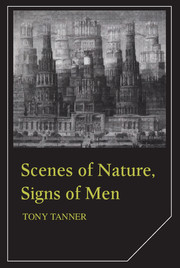Book contents
- Frontmatter
- Contents
- Preface
- 1 Scenes of nature, signs of men
- 2 Notes for a comparison between American and European Romanticism
- 3 Problems and roles of the American artist as portrayed by the American novelist
- 4 James on Hawthorne
- 5 The lost America – the despair of Henry Adams and Mark Twain
- 6 Henry James and Henry Adams
- 7 William Dean Howells and A Hazard of New Fortunes
- 8 Stephen Crane
- 9 The Bostonians and the human voice
- 10 Games American writers play: ceremony, complicity, contestation, and carnival
- 11 Toward an ultimate topography: the work of Joseph McElroy
- 12 Frames and sentences
- 13 William Gass's barns and bees
- Index
- Frontmatter
- Contents
- Preface
- 1 Scenes of nature, signs of men
- 2 Notes for a comparison between American and European Romanticism
- 3 Problems and roles of the American artist as portrayed by the American novelist
- 4 James on Hawthorne
- 5 The lost America – the despair of Henry Adams and Mark Twain
- 6 Henry James and Henry Adams
- 7 William Dean Howells and A Hazard of New Fortunes
- 8 Stephen Crane
- 9 The Bostonians and the human voice
- 10 Games American writers play: ceremony, complicity, contestation, and carnival
- 11 Toward an ultimate topography: the work of Joseph McElroy
- 12 Frames and sentences
- 13 William Gass's barns and bees
- Index
Summary
A story first – from a newspaper. In connection with the Pope's planned visit to England in 1982 the Royal Mint produced ‘an object called a plaque in precious metals which features medallions of Her Majesty and His Holiness vis-a-vis’. The then Protestant Conservative MP, Enoch Powell – whatever else, a formidable intellectual and forensic logician – did not like the look of this at all. He wrote: ‘The political overtones of the Royal Mint striking a medal in commemoration of a papal visit of the United Kingdom, bearing Her Majesty's effigy at all, let alone in conjunction with the papal effigy, are obvious. Whose then is the responsibility?’ He went on to record how he tried to find precisely whose responsibility it was to give ‘permission to use representations’ of the Sovereign: tracking this responsibility to its source proved to be curiously difficult. Chancellor of the Exchequer? He denied responsibility. Try the Lord Chamberlain; he referred him to the ‘Comptroller’, whoever that Dickensian figure may be. He was directed to the Exchequer for the Royal Mint – well, he said, if he got clearance, it was ‘no concern of mine on what, and for what purposes and in what context that effigy (representation) is used’. Enoch Powell is surely right in asserting that ‘a politically charged decision’ had been taken, and I take it as something of a parable that he could not finally trace the power which issues the ‘permission to use representations’ to its source.
- Type
- Chapter
- Information
- Scenes of Nature, Signs of MenEssays on 19th and 20th Century American Literature, pp. 238 - 247Publisher: Cambridge University PressPrint publication year: 1987

